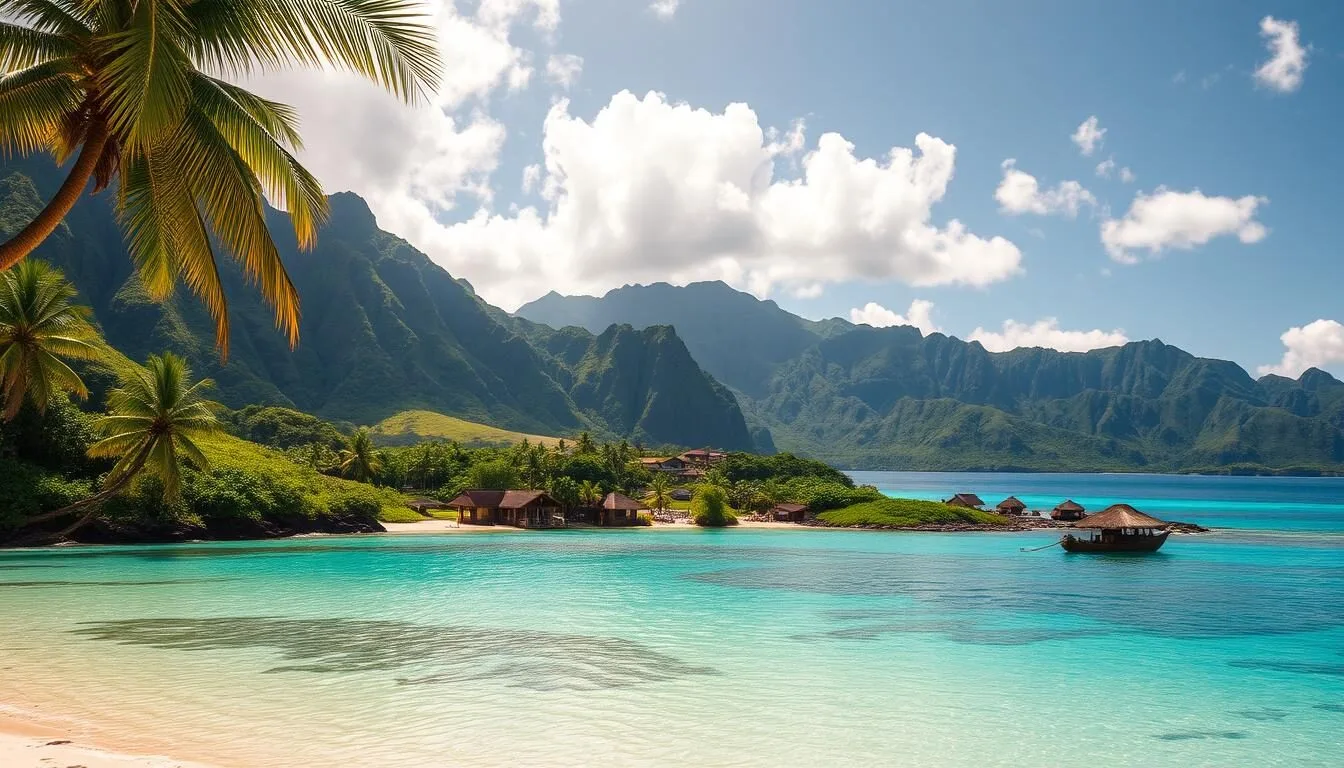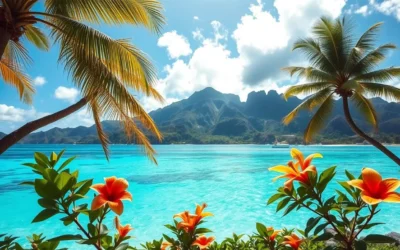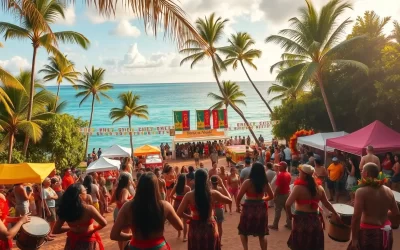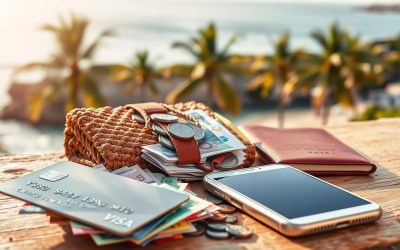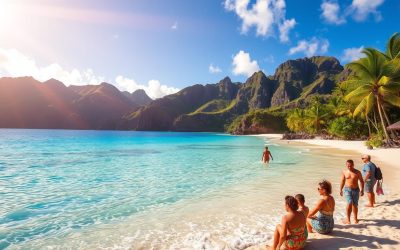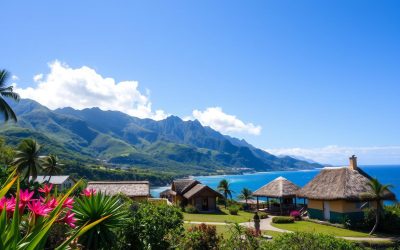✓ Accommodations ✓ Flights ✓ Rental Cars ✓ Tours & Activities
You’ve probably heard of Samoa, but have you considered its lesser-known neighbor, American Samoa? This unincorporated U.S. territory in the South Pacific is a treasure trove of pristine beaches, lush rainforests, and rich Polynesian culture.
Imagine spending your trip exploring the national park spread across three islands, snorkeling in stunning marine sanctuaries, and immersing yourself in the local culture. With its unique status as the southernmost U.S. territory, American Samoa offers an unforgettable experience.
Planning your visit at the right time can make all the difference. As you prepare for your journey, you’ll want to know the things to do and see in this South Pacific gem, making your trip truly unforgettable.
Discovering American Samoa: A South Pacific Paradise
As you step into the untouched beauty of American Samoa, you’ll discover a South Pacific paradise that remains hidden from the typical tourist trail. This U.S. territory in the Pacific Ocean is a treasure trove of natural wonders, rich cultural heritage, and unspoiled landscapes.
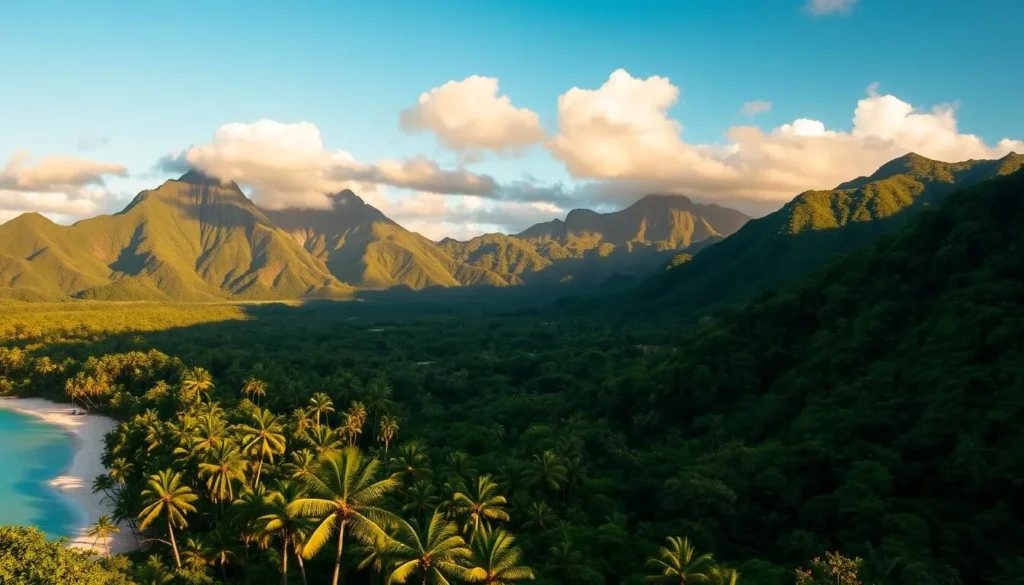
Geography and Location
American Samoa is located in the southern Pacific Ocean, southeast of Samoa. It comprises seven islands, with the largest being Tutuila. The islands are known for their lush rainforests, rugged mountains, and pristine beaches. The unique geography of American Samoa creates a diverse range of ecosystems, from coral reefs to volcanic landscapes.
| Island | Main Attractions | Notable Features |
|---|---|---|
| Tutuila | Pago Pago Harbor, National Park | Largest island, capital city |
| Ofu and Olosega | Ofu Beach, coral reefs | Pristine beaches, snorkeling spots |
| Ta’u | National Park, scenic views | Less populated, natural beauty |
Brief History and Culture
American Samoa has a rich cultural heritage, deeply rooted in the Fa’a Samoa, or “The Samoan Way.” The islands have a history dating back over 3,000 years, with influences from European explorers and American governance. Traditional Samoan village life remains vibrant, with practices such as tattooing, dance, and handicrafts still prevalent. Visitors can experience the local culture by attending a traditional Samoan fiafia night or visiting a village.
Why Visit American Samoa
Visiting American Samoa offers a unique blend of natural beauty and cultural immersion. You can explore the National Park of American Samoa, relax on beautiful beaches like Ofu Beach, and experience the local culture firsthand. Whether you’re hiking through rainforests, snorkeling in crystal-clear waters, or simply enjoying the serene atmosphere, American Samoa is a destination that will leave you with unforgettable memories. So, visit American Samoa to discover its untouched charm and hospitality.
Planning Your Trip to American Samoa
Planning a trip to American Samoa requires some preparation to make the most of your island adventure. With its unique culture, stunning landscapes, and rich history, American Samoa is a destination that promises an unforgettable experience.
Best Time to Visit
The best time to visit American Samoa is during the dry season, which typically runs from April to October. This period offers the most favorable weather conditions for outdoor activities such as snorkeling, hiking, and exploring the island’s natural beauty. The wet season, from November to March, can bring heavy rainfall and higher humidity, but it’s also a great time to enjoy the island’s lush vegetation and fewer tourists.
Understanding the seasonal variations will help you plan your activities and make the most of your time on the island.
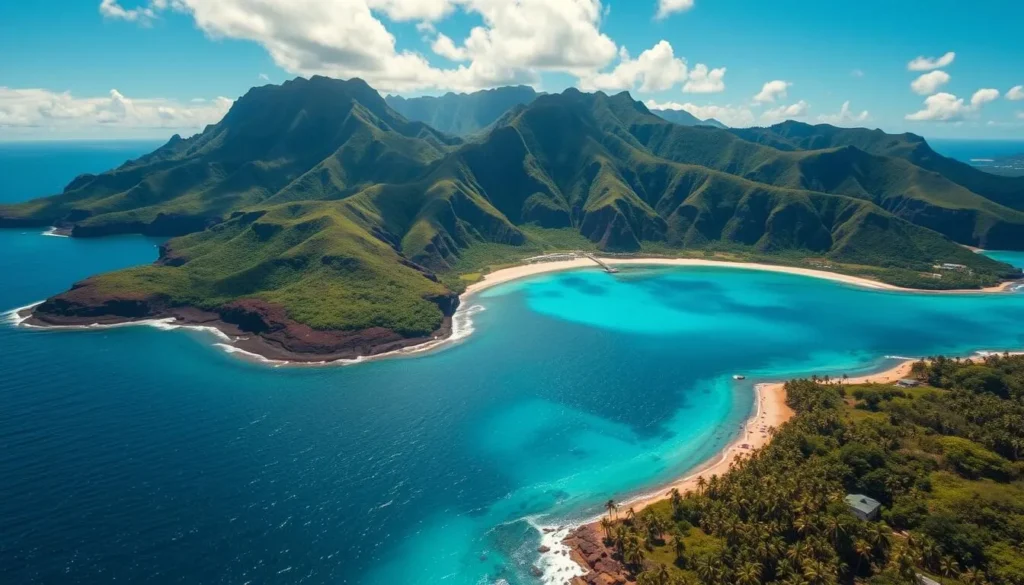
Visa Requirements
As a U.S. territory, American Samoa has specific entry requirements. U.S. citizens do not need a visa to enter American Samoa, but they must have a valid U.S. passport. Non-U.S. citizens should check the specific visa requirements for their country, as these can vary. It’s also a good idea to ensure your passport is valid for at least six months beyond your planned departure date from American Samoa.
Currency and Budget Considerations
The U.S. dollar is the official currency in American Samoa. While this simplifies things for U.S. travelers, it’s essential to budget appropriately for your trip. Prices in American Samoa tend to be higher than on the mainland due to its remote island location. You should expect to pay premium prices for accommodations, with standard hotels on Tutuila ranging from around $150-250 per night.
- Plan for transportation costs, including car rentals at approximately $60-80 per day, or budget for bus fares ($1 per ride).
- Set aside money for village entrance fees and beach access, as many beautiful spots require small payments of $5-10.
- Bring sufficient cash for your entire stay, as ATMs are limited, and credit cards may not be accepted at smaller establishments or on outer islands.
By budgeting wisely and understanding the local costs, you can enjoy a stress-free and enjoyable trip to this beautiful island.
How to Get to American Samoa
American Samoa is a hidden gem in the Pacific, and we’re here to guide you on how to get there. Located in the southern Pacific Ocean, American Samoa is a US territory that offers a unique blend of Samoan culture and American convenience.
Flights from the United States
To get to American Samoa, you’ll typically fly from the United States to Honolulu, Hawaii, and then connect to a flight to Pago Pago, the capital of American Samoa. Hawaiian Airlines is one of the primary carriers that offer this route. You should plan ahead and book your flights early to ensure availability, especially during peak travel seasons.
The total travel time from the US mainland to American Samoa can vary depending on your departure city and layovers, but on average, it takes around 14-16 hours, including connections.
Flights from Other Pacific Islands
If you’re already in the Pacific, you can also fly to American Samoa from other islands. Samoa Airways and Talofa Airways offer regional flights that connect American Samoa to neighboring islands. However, flight schedules can be limited, so it’s essential to plan your trip accordingly.
Crossing the International Date Line
One unique aspect of traveling to American Samoa is crossing the International Date Line. When flying from Samoa to American Samoa, you’ll essentially “travel back in ” and arrive the day before you departed. This can be confusing, but it’s also a novel experience of living the same day twice. Be sure to plan accordingly and double-check your travel arrangements to avoid any confusion.
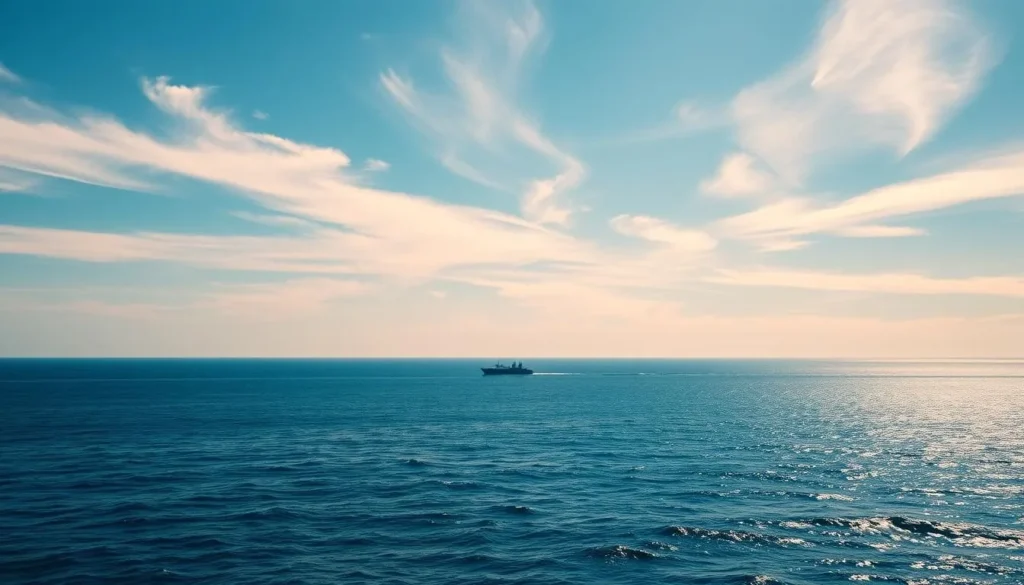
To make the most of your trip, prepare for this unique experience by understanding the implications of crossing the International Date Line on your travel plans.
Where to Stay in American Samoa
Whether you’re looking for a beachside retreat or a cultural immersion, American Samoa’s accommodations have got you covered. From luxury hotels to homestays with local families, you can experience the best of this South Pacific paradise.
Tradewinds Hotel

The Tradewinds Hotel is a popular choice among travelers, offering comfortable rooms and a range of amenities. Located in the heart of American Samoa, it’s an ideal base for exploring the islands.
Sadie’s by the Sea
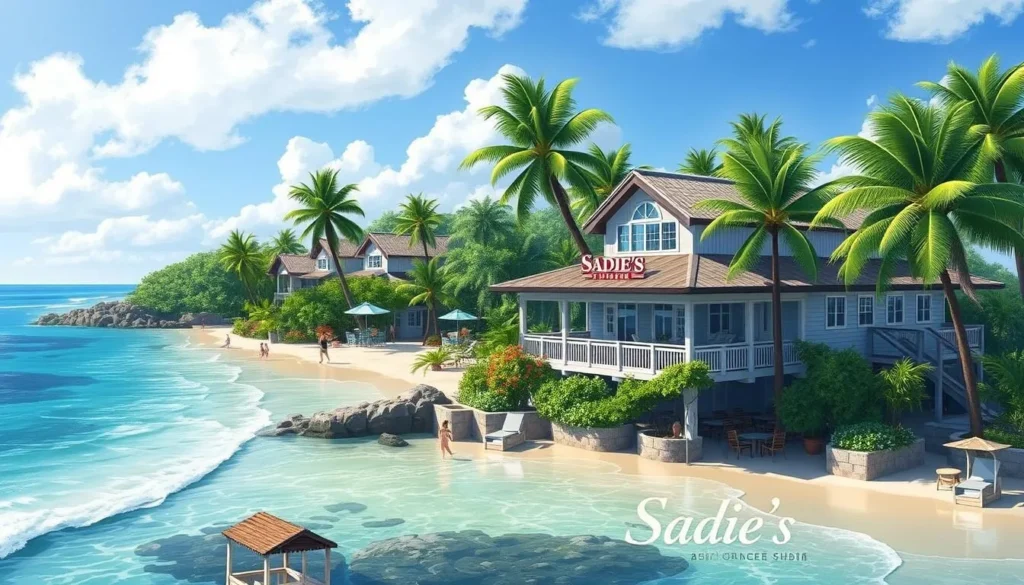
Sadie’s by the Sea is a charming beachfront property that offers a relaxing stay with stunning ocean views. It’s perfect for those looking to unwind in a beautiful setting.
Tisa’s Barefoot Bar
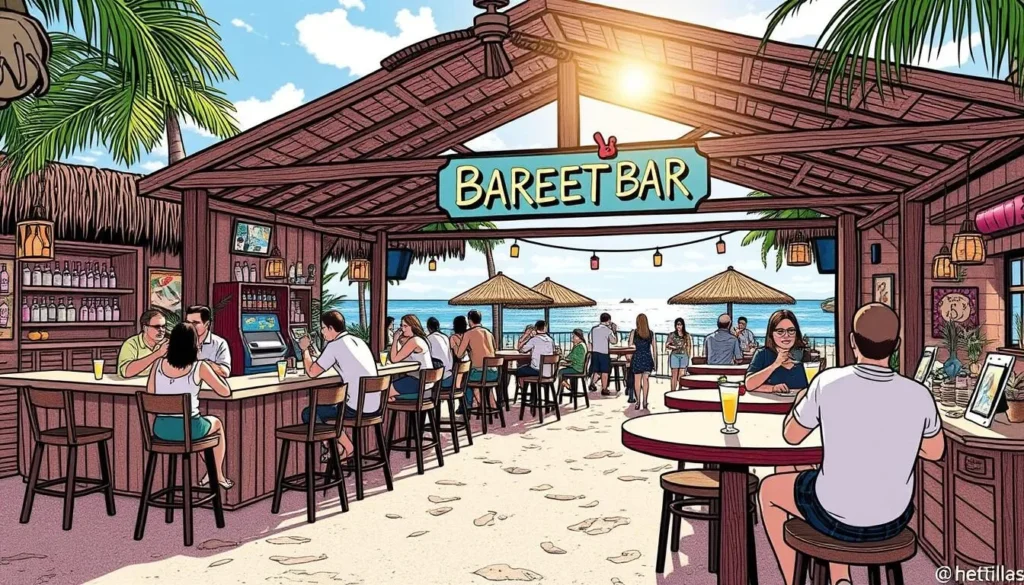
Tisa’s Barefoot Bar is a local favorite, known for its laid-back vibe and delicious food. It’s a great spot to meet locals and enjoy the island lifestyle.
Homestay Options
For a truly authentic experience, consider a homestay with a Samoan family. You can live with local people in their home, learn about daily life in a Samoan village, and enjoy home-cooked meals. The National Park Service’s homestay program arranges these experiences, allowing you to connect with the community and respect local customs.
- Experience traditional Samoan hospitality and learn about local customs.
- Participate in family and community activities for a deeper cultural understanding.
- Contact the National Park Visitor Center for information on participating families and to arrange your homestay.
Getting Around American Samoa
Whether you’re looking to rent a car, hop on a bus, or simply walk, American Samoa provides various transportation methods to discover its hidden gems. The islands offer a range of ways to get around, catering to different preferences and needs.
Rental Cars
Renting a car is a convenient way to explore American Samoa at your own pace. Several car rental services are available, offering a variety of vehicles suitable for the island’s terrain. This option gives you the flexibility to visit remote areas and enjoy scenic views without relying on public transport schedules.
Public Buses
Public buses are another way to get around, providing an affordable and relatively reliable means of transportation. Buses connect major villages and towns, making it easier for you to experience local life. You can interact with the friendly people who live and work in these areas, gaining insights into their daily routines and culture.
Walking and Hitchhiking
For shorter distances, walking is a viable option, especially within villages or towns. However, be prepared for hot, humid conditions and limited sidewalks along many roads. Hitchhiking is also common and generally safe in American Samoa, where locals are known for their hospitality. To hail a ride, simply extend your arm with your palm facing down, following the traditional Samoan custom. When walking or hitchhiking, respect local customs, such as dressing modestly, and allow extra time for your journey as these methods are less predictable.
National Park of American Samoa: Must-See Attractions
The National Park of American Samoa is a treasure trove of natural wonders, waiting to be explored. As you venture into this stunning park, you’ll encounter a diverse range of landscapes, from lush rainforests to rugged coastlines.
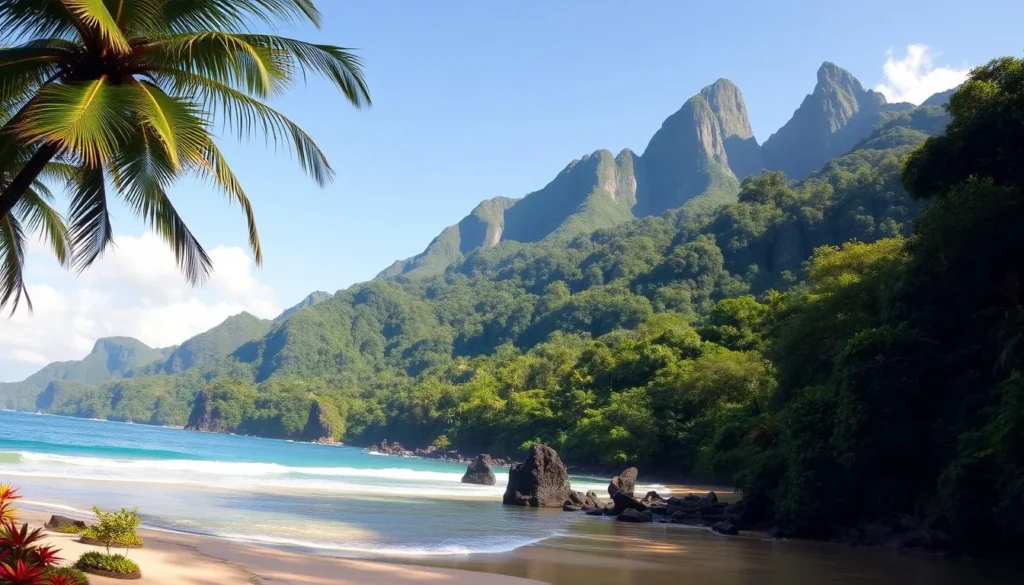
Pola Island and Vai’ava Strait Viewpoint
One of the park’s most breathtaking attractions is the Pola Island and Vai’ava Strait Viewpoint. This scenic spot offers a panoramic view of the turquoise strait and the picturesque Pola Island. You can enjoy the stunning vista, take memorable photos, and appreciate the unique geology of the area.
Lower Sauma Ridge Trail
For those who love hiking, the Lower Sauma Ridge Trail is a must-try. This moderately difficult trail takes you through a lush tropical forest, offering glimpses of the surrounding landscape. As you hike, keep an eye out for the diverse flora and fauna that call this trail home.
Mount ‘Alava Adventure Trail
The Mount ‘Alava Adventure Trail is another highlight of the National Park. This challenging hike rewards you with spectacular views from the summit, where you can see the surrounding islands and coastline. Be sure to bring plenty of water and snacks, as this trail can be demanding.
Tumu Mountain Trail
Located on Ofu Island, the Tumu Mountain Trail is a rewarding hike that offers breathtaking views of the island and its famous beach. The trail takes you through a lush tropical forest and ascends to a grassy summit, where you can enjoy a picnic and take in the panoramic view. It’s recommended to hike early in the morning to avoid the heat and humidity.
| Trail Name | Difficulty Level | Notable Features |
|---|---|---|
| Lower Sauma Ridge Trail | Moderate | Lush tropical forest, diverse flora and fauna |
| Mount ‘Alava Adventure Trail | Challenging | Spectacular views from the summit, surrounding islands and coastline |
| Tumu Mountain Trail | Moderate | Breathtaking views of Ofu Island and its famous beach, picnic area at the summit |
As you explore the National Park of American Samoa, remember to respect the local culture and environment. Trails are closed on Sundays out of respect for Samoan cultural practices, so plan your hikes accordingly.
Best Beaches in American Samoa
The beaches of American Samoa are renowned for their breathtaking beauty and tranquility. With their crystal-clear waters and lush surroundings, they offer a perfect setting for relaxation and adventure. You can enjoy a variety of activities, from snorkeling and swimming to simply basking in the sun.
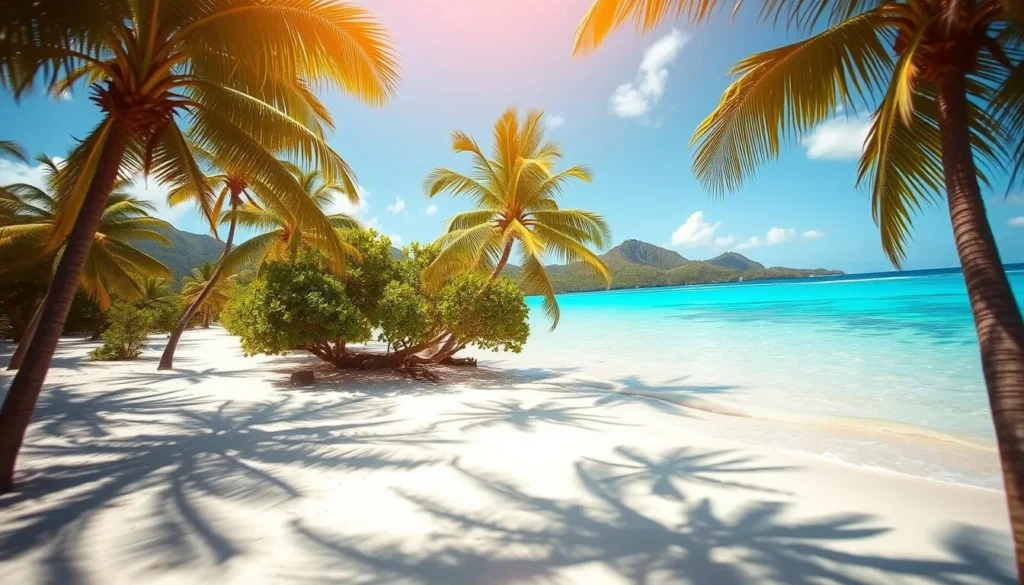
Ofu Beach
Ofu Beach is one of the most picturesque beaches in American Samoa, known for its pristine sands and vibrant coral reefs. The beach is surrounded by lush greenery and offers stunning views of the surrounding landscape. You can enjoy snorkeling, swimming, or simply relaxing on the beach. The beach is easily accessible and provides a serene atmosphere, making it an ideal spot for those looking to escape the hustle and bustle of daily life.
Snorkeling at Ofu Beach is a must-do activity, with an array of marine life to discover. The coral reefs are home to a diverse range of fish and other marine creatures, making it a great spot for snorkeling and exploring the underwater world.
Two Dollar Beach
Two Dollar Beach, named for the nominal fee once charged for parking, is a popular spot for both locals and tourists. The beach boasts clear waters and soft sands, making it perfect for a day of sunbathing or a leisurely swim. You can also enjoy the scenic views of the surrounding area, which add to the beach’s charm.
This beach is easily accessible and offers basic amenities, making it a convenient choice for those looking to spend a day by the sea. The calm waters make it an ideal spot for families with children.
Alega Beach
Alega Beach is another gem on the island of Tutuila, offering a more secluded experience compared to some of the other beaches. The beach is surrounded by rugged cliffs and lush vegetation, providing a picturesque backdrop for a day of relaxation. You can enjoy swimming, snorkeling, or simply taking in the natural beauty of the area.
The beach is relatively untouched, maintaining its natural charm and making it a great spot for those looking to escape the crowds.
Fatumafuti Beach
Fatumafuti Beach is a small but scenic spot located along the main road on the south side of Tutuila Island. You can enjoy the gorgeous view across Pago Pago Harbor while relaxing on this easily accessible beach. Try snorkeling at this location, which local National Park rangers recommend as one of the best spots on Tutuila. Note that the beach is open from 6am to 6pm, Monday through Saturday, and swimming is not allowed on Sundays in keeping with local customs.
- Visit Fatumafuti Beach for its scenic views and snorkeling opportunities.
- Enjoy the view across Pago Pago Harbor.
- Take advantage of the convenient parking area next to the beach.
Exploring Pago Pago Harbor
Pago Pago Harbor is a must-visit destination, providing a mix of history, culture, and natural beauty. As you explore this vibrant area, you’ll discover a range of attractions that showcase the best of American Samoa.
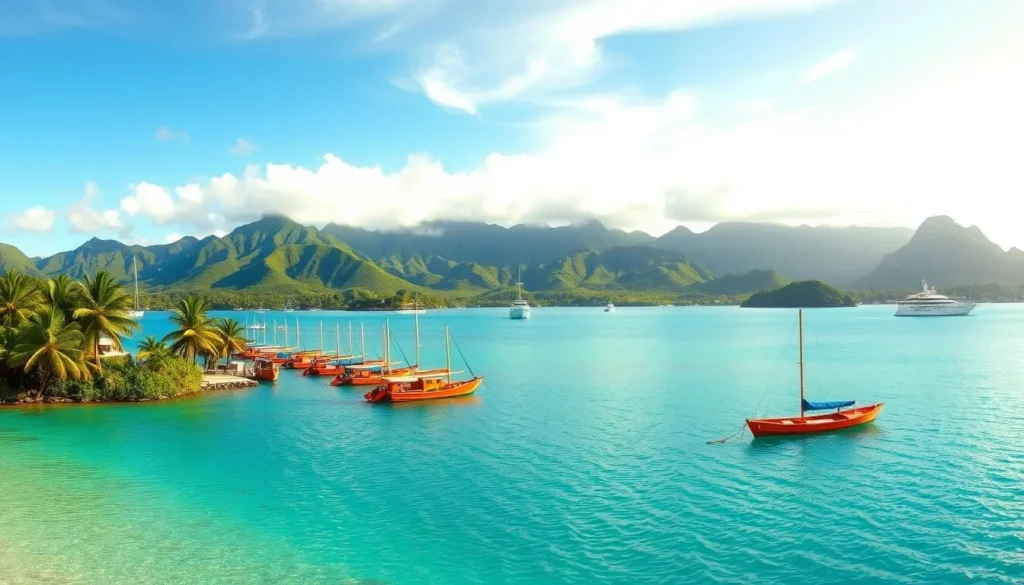
National Park Visitor Center
The National Park Visitor Center is an excellent starting point for your exploration of Pago Pago Harbor. Here, you can gather information about the National Park of American Samoa, learn about its unique ecosystems, and get insights into the various trails and attractions within the park.
Jean P. Haydon Museum
The Jean P. Haydon Museum is another significant attraction near the harbor. This museum offers a glimpse into the history and culture of American Samoa, featuring exhibits on the island’s heritage, traditional crafts, and historical artifacts.
National Marine Sanctuary of American Samoa Visitor Center
For those interested in marine life, the National Marine Sanctuary of American Samoa Visitor Center is a great place to visit. The center provides information about the sanctuary’s conservation efforts, the diverse marine ecosystems, and the importance of protecting these resources.
Historic Tramway Site
Visit the historic tramway site overlooking Pago Pago Harbor to see one of the old tramway cars that once carried visitors to the summit of Mount ‘Alava. You can learn about the aerial tramway that operated from the 1960s until it was damaged by a hurricane in 1992. Enjoy one of the easiest accessible panoramic views over the harbor from the pavilion near the tramway car, and photograph the dramatic landscape of steep mountains surrounding the harbor.
- Explore the historic tramway site and its remnants.
- Take in the panoramic views of Pago Pago Harbor.
- Capture the dramatic landscape through photography.
Best Hiking Trails in American Samoa
The hiking trails in American Samoa are a testament to the islands’ unspoiled natural beauty and are a must-visit for outdoor enthusiasts. With trails ranging from easy strolls to challenging hikes, there’s something for every kind of hiker.
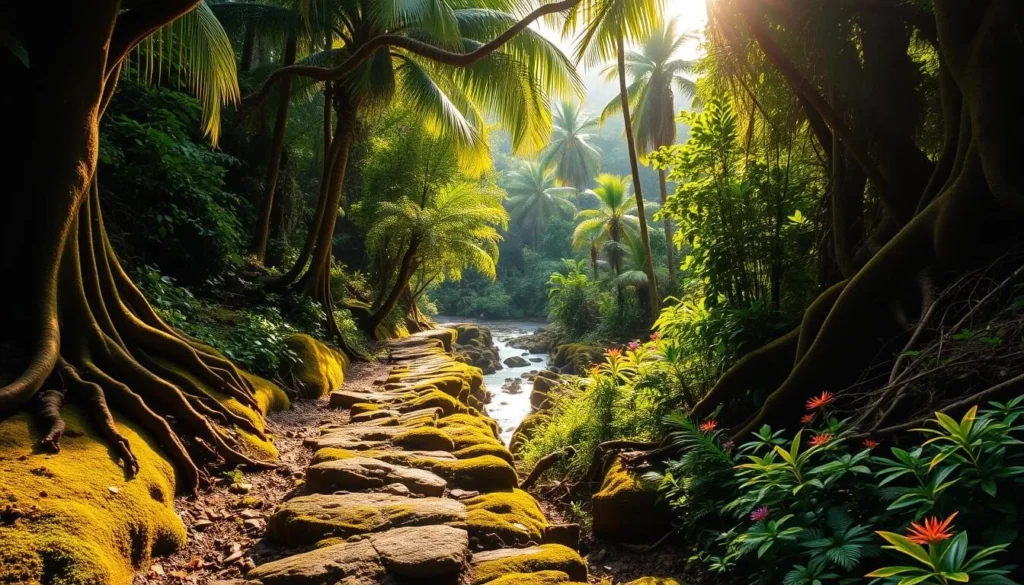
Blunts Point Trail
The Blunts Point Trail is a historical hike that offers a glimpse into American Samoa’s military past. This moderate trail takes you through a lush landscape to a historic site with remnants of old military installations. You’ll enjoy the scenic views and the opportunity to explore the island’s history.
WWII Heritage Trail
For a dose of history and culture, the WWII Heritage Trail is a must-hike. This trail is a self-guided tour that takes you through significant WWII sites, providing insight into the island’s role during the war. The trail is relatively easy and is suitable for families.
Nuuuli Falls Trail
Nuuuli Falls Trail is a scenic hike that leads to a beautiful waterfall. The trail is moderately difficult and takes you through a lush forest, ending at the picturesque Nuuuli Falls. It’s a great spot for a picnic and to enjoy the natural beauty of American Samoa.
Oge Beach Trail
The Oge Beach Trail on Olosega Island is a challenging but rewarding hike. You begin at the far end of Olosega Village, climbing up the side of Mata’ala Ridge before descending steeply to Oge Beach. It’s essential to contact the National Park ranger on Ofu to obtain permission from the village chief before embarking on this trail, respecting local land ownership. The spectacular views from the ridge top are a bonus, even if you choose not to descend all the way to the beach.
| Trail Name | Difficulty Level | Notable Features |
|---|---|---|
| Blunts Point Trail | Moderate | Historic military sites |
| WWII Heritage Trail | Easy | WWII historical sites |
| Nuuuli Falls Trail | Moderate | Waterfall, lush forest |
| Oge Beach Trail | Challenging | Secluded beach, scenic views |
When hiking in American Samoa, remember that trails are closed on Sundays out of respect for local customs. Always check with local authorities or park rangers for any specific regulations or permissions needed for your hike. Enjoy the natural beauty and unique landscapes that these trails have to offer, from the secluded beaches to the historic sites.
Day Trips to Aunu’u Island
If you’re looking for an adventure beyond the main island of American Samoa, consider a day trip to Aunu’u Island. This small island, just a short boat ride away, offers a unique blend of natural beauty, cultural experiences, and relaxation.
How to Get to Aunu’u
To visit Aunu’u Island, you’ll need to catch a boat from the Au’asi dock. It’s advisable to arrive early to secure a spot on the morning boat, maximizing your day on the island. The boat fare is typically paid in cash, so be sure to bring sufficient funds.
Pala Lake with Red Quicksand
One of the island’s most fascinating attractions is Pala Lake, known for its red quicksand. This natural phenomenon is not only intriguing but also offers great photo opportunities. Be cautious when approaching the area to avoid getting too close to the quicksand.
Tide Pools and Sea Arches
Aunu’u Island is also renowned for its tide pools and sea arches, perfect for exploration during low tide. These natural formations are home to a variety of marine life, making them a great spot for nature lovers and photographers.
Tips for Visiting Aunu’u
To make the most of your day trip, remember to pack essentials like water, snacks, sun protection, and insect repellent. Dress modestly and respect local customs, especially when walking through the village. Consider hiring a local guide to enhance your experience of the island.
- Arrive at the Au’asi dock early to catch the morning boat.
- Bring cash for the boat fare and any purchases.
- Pack everything you need for the day, including sun protection and appropriate footwear.
- Respect local customs by dressing modestly and asking permission before taking photos.
- Consider hiring a local guide for a more enriching experience.
Visiting the Manu’a Islands
The Manu’a Islands, comprising Ofu, Olosega, and Ta’u, offer a unique blend of culture, history, and natural beauty. Located in the heart of the Pacific, these islands are a treasure trove of experiences waiting to be discovered.
Getting to Ofu and Ta’u
To get to the Manu’a Islands, you can fly from Tutuila, the main island of American Samoa, to Ofu or Ta’u. Ofu Airport and Ta’u Airport receive flights operated by Inter Island Airways or American Samoa Government’s airline. The flight offers breathtaking views of the Pacific and is a thrilling start to your island adventure.
Accommodation Options
Accommodation in the Manu’a Islands ranges from simple guesthouses to eco-lodges. You can stay in Ofu at the Va’oto Lodge, which offers comfortable rooms and stunning views. On Ta’u, there are more rustic options that allow you to immerse yourself in the local culture and natural surroundings.
Top Attractions in the Manu’a Islands
The Manu’a Islands are home to some of the most spectacular attractions in American Samoa. You can:
- Visit world-famous Ofu Beach, known for its perfect white sand and turquoise waters.
- Hike up Tumu Mountain on Ofu for panoramic views of the island.
- Explore the Olosega side of the islands by crossing the short bridge that connects it to Ofu.
- Discover Ta’u Island’s ancient rainforest and the massive To’aga archaeological site.
- Snorkel the pristine reefs around the Manu’a Islands, home to healthy and resilient coral.
With their unspoiled landscapes and rich cultural heritage, the Manu’a Islands are a must-visit destination for any traveler to American Samoa.
Wildlife and Nature Experiences
With its lush forests, coral reefs, and diverse wildlife, American Samoa provides a unique opportunity to connect with nature. As you explore this Pacific island, you’ll have the chance to encounter a wide range of fascinating creatures and ecosystems.
Fruit Bats (Flying Foxes)
One of the most iconic creatures in American Samoa is the fruit bat, also known as the flying fox. These large bats play a crucial role in pollinating and dispersing seeds throughout the island’s forests. You can spot them roosting in trees or flying overhead, particularly at dawn and dusk.
Marine Life and Snorkeling
The waters around American Samoa are home to an incredible array of marine life, including sea turtles, colorful fish, and coral. Snorkeling is a great way to experience this underwater world, with numerous sites accessible from the shore or by boat. Keep an eye out for humpback whales during the migration season from August to November.
- Spot sea turtles while snorkeling or sometimes nesting on beaches.
- Explore the coral reefs, home to a diverse range of fish and other marine creatures.
- Watch for whales during the migration season.
Coconut Crabs and Other Wildlife
American Samoa is also home to a variety of other wildlife, including the impressive coconut crab, the largest land arthropod in the world. These crabs can be found throughout the island, particularly on Ofu Island, and are most active at night. You may also encounter other creatures such as tropicbirds, noddies, and terns, especially in the forested areas of the National Park.
| Wildlife | Location | Best Time to Spot |
|---|---|---|
| Fruit Bats | Forests | Dawn and Dusk |
| Coconut Crabs | Ofu Island, rocky areas | Night |
| Sea Turtles | Beaches, coral reefs | Day, while snorkeling |
Cultural Experiences in American Samoa
Immersing yourself in the Samoan culture is a highlight of any trip to American Samoa. The territory’s unique cultural identity is shaped by its Polynesian roots and Pacific Islander influences, offering visitors a rich and authentic cultural experience.
Understanding Fa’a Samoa (The Samoan Way)
Fa’a Samoa, or “The Samoan Way,” is a concept that encompasses the traditional Samoan lifestyle, values, and customs. It emphasizes respect for elders, community cohesion, and a deep connection with the land and the sea. As you explore American Samoa, you’ll have opportunities to experience Fa’a Samoa firsthand, whether through village visits, traditional ceremonies, or simply interacting with the local community.
Key aspects of Fa’a Samoa include:
- Respect for elders and traditional authority
- Community-oriented lifestyle
- Strong connection to the land and natural resources
Village Etiquette and Customs
When visiting villages in American Samoa, it’s essential to respect local customs and etiquette. This includes dressing modestly, removing your shoes when entering homes or churches, and participating respectfully in traditional ceremonies. By showing respect for local customs, you’ll be warmly welcomed by the community and have a more authentic experience.
Some key customs to keep in mind:
- Dress modestly, covering shoulders and knees
- Remove shoes when entering homes or churches
- Participate respectfully in traditional ceremonies
Fiafia Nights and Traditional Performances
One of the highlights of your cultural experience in American Samoa will be attending a fiafia night. These events feature traditional Samoan dance, music, and cultural performances that showcase the territory’s rich heritage. You can expect to see the spectacular fire knife dance (siva afi), enjoy traditional Samoan dances that tell stories of island life, and listen to beautiful Samoan singing accompanied by traditional instruments.
Some highlights of fiafia nights include:
- Watching the fire knife dance (siva afi)
- Enjoying traditional Samoan dances and music
- Sampling traditional Samoan foods
Food and Dining in American Samoa
Samoan cuisine, with its emphasis on fresh seafood, coconut milk, and root vegetables, is a highlight of any trip to American Samoa. The local food scene is a reflection of the island’s rich cultural heritage and its geographical location in the Pacific.
Traditional Samoan Cuisine
Traditional Samoan dishes are characterized by their simplicity and the use of local ingredients. Fa’alifu, a dish made with raw fish marinated in coconut milk and lime juice, is a staple. Other popular dishes include palusami (steamed taro and coconut cream wrapped in banana leaves) and panipopo (a sweet coconut milk dessert). These dishes not only showcase the flavors of American Samoa but also highlight the importance of food in Samoan culture.
Best Restaurants in Pago Pago
Pago Pago, the capital of American Samoa, offers a variety of dining options that cater to different tastes and preferences. Some of the top restaurants include Sadie’s by the Sea, known for its seafood and waterfront views, and the Tradewinds Hotel’s restaurant, which serves a mix of local and international cuisine. When dining out, be sure to try some of the local specialties to experience the authentic flavors of the island.
Grocery Shopping Tips
If you plan to self-cater or visit the outer islands, it’s essential to stock up on groceries at the larger supermarkets in the Pago Pago and Tafuna areas. The Fagatogo Market near the bus station in Pago Pago is a great place to buy fresh local produce. Be aware that grocery stores on the outer islands have limited selections, primarily stocking processed foods. Plan your shopping around store hours, as many places close early on Saturdays and remain closed on Sundays. You can also purchase local specialties like koko Samoa (Samoan cocoa) or locally grown coffee as souvenirs, giving you a taste of the island’s flavors.
Practical Tips for Visiting American Samoa
To make the most of your time on this beautiful island, consider these essential tips for visiting American Samoa. Being prepared will enhance your experience and ensure a smooth journey.
Sunday Observances
American Samoa is deeply rooted in its Samoan culture and Christian faith, making Sundays a day of rest. You should respect local customs by avoiding commercial activities and loud gatherings. Most businesses, including shops and restaurants, are closed on Sundays, so plan your activities accordingly.
Internet and Mobile Connectivity
Staying connected is relatively easy in American Samoa, with mobile coverage available in most areas, especially on Tutuila. However, internet speeds can be slower than what you’re used to, and connectivity might be limited in outer islands like the Manu’a Islands. Be sure to check with your service provider about international data roaming.
Weather and What to Pack
The tropical climate in American Samoa means it’s warm and humid year-round. Pack lightweight, breathable clothing, sunscreen, and a hat to protect yourself from the sun. During the rainy season, which typically runs from November to April, it’s a good idea to bring a waterproof jacket or umbrella. Comfortable hiking shoes are also a must for exploring the island’s natural beauty.
Health and Safety
Your health and safety are paramount when traveling to American Samoa. Here are some key tips to keep in mind:
- Bring a basic first aid kit, including remedies for common travel ailments, as pharmacies are limited and may not carry familiar brands.
- Protect yourself from mosquitoes with effective repellent, as dengue fever can occur, particularly during the rainy season.
- Stay hydrated by drinking bottled or properly treated water, as tap water may not be potable in all areas.
- Be cautious when swimming or snorkeling, respecting warning signs and local advice about currents and marine hazards.
- Know that the LBJ Tropical Medical Center in Faga’alu is the main hospital on Tutuila, but medical facilities are very limited on outer islands, so consider travel insurance that includes medical evacuation.
By being aware of these practical tips, you can have a safe and enjoyable trip to American Samoa, making the most of your time on this beautiful island.
Conclusion: Making the Most of Your American Samoa Adventure
American Samoa awaits your visit, promising an enriching experience that blends traditional Polynesian culture with American influences. As you plan your trip to this South Pacific paradise, you’ll discover a treasure trove of unique experiences that will leave a lasting impression.
One of the most significant aspects of traveling to American Samoa is embracing the slower pace of “island time.” Allow yourself to adjust to the local rhythm and fully immerse in the authentic character of the island. Consider combining your trip with visits to nearby Pacific destinations like independent Samoa, Hawaii, Tonga, or Fiji for a more comprehensive South Pacific experience.
Visiting American Samoa is a privilege, as it’s one of America’s most remote and least-touristed territories. Take home not just photographs but a deeper understanding of Fa’a Samoa (the Samoan Way) and the natural wonders of this paradise. You may also want to plan a return visit to explore areas you missed, particularly the Manu’a Islands.
- Share your experiences to promote sustainable tourism to this deserving destination.
- Support local conservation efforts that protect American Samoa’s precious natural resources.
- Maintain connections with the friendly people you meet, as these relationships often become treasured souvenirs.
- Carry the spirit of American Samoa with you, incorporating lessons of community and respect for tradition into your daily life.
By embracing the unique aspects of American Samoa, you’ll not only enrich your travel experience but also contribute to the preservation of this special place. As you reflect on your journey, remember that the memories and lessons from American Samoa will stay with you long after your departure, leaving a lasting impact on your life.
The above is subject to change.
Check back often to TRAVEL.COM for the latest travel tips and deals.
